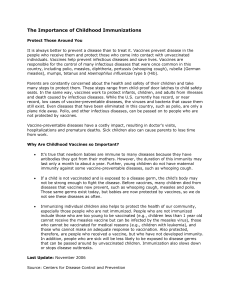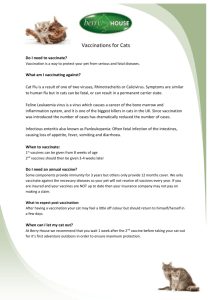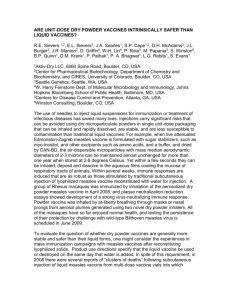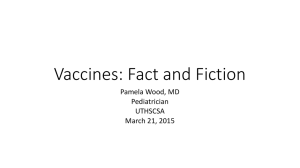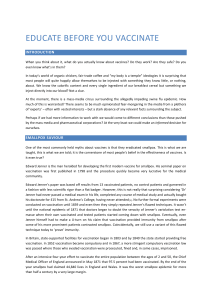Vaccination
advertisement
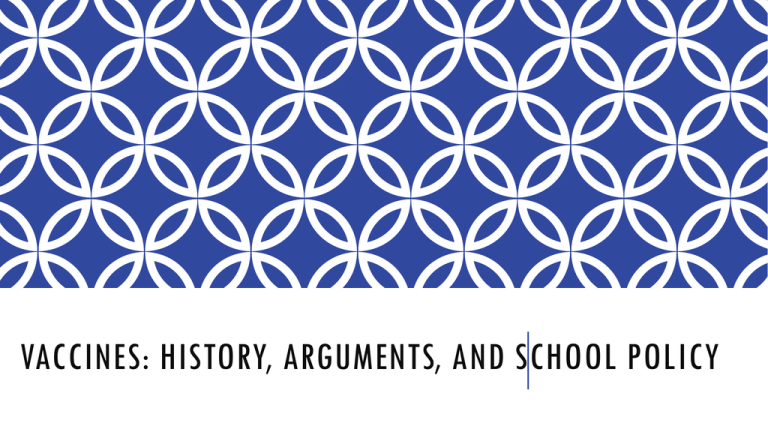
VACCINES: HISTORY, ARGUMENTS, AND SCHOOL POLICY Somewhere over the rainbow Looking out for #1 Put two and two together VACCINES: HISTORY, ARGUMENTS, AND SCHOOL POLICY Learning Goal: Understand the history of disease and vaccines, and recognize the tension between respecting an individual’s choice not to be vaccinated and the need for widespread vaccination to ensure the health of the entire community. Vaccination: Injection of a killed microbe in order to stimulate the immune system against the microbe, thereby preventing disease. Also known as Immunizations Works by stimulating the immune system, the natural disease-fighting system of the body. The healthy immune system is able to recognize invading bacteria and viruses and produce antibodies to destroy or disable them. Immunizations prepare the immune system to ward off a disease Immunity and Vaccines Explained Key Facts: 1. Vaccines have greatly reduced the incidence of infectious diseases historically 2. Not everybody can receive vaccinations (medical and religious reasons) Immunosuppressed/immuno compromised individuals who have a wreaked or no immune system have no natural fighters to ward off even the smallest dose of a live vaccine. Certain religions and belief systems promote alternative perspectives toward vaccination. Religious objections to vaccines are based generally on (1) the ethical dilemmas associated with using human tissue cells to create vaccines, and (2) beliefs that the body is sacred, should not receive certain chemicals or blood or tissues from animals, and should be healed by God or natural means. 3. Everyone in the community is protected from outbreaks if a large percentage of members of the community are vaccinated; this is called Herd Immunity (Community Immunity). 4. Once the number of people fall below a certain threshold, the disease can regain a foothold and all unvaccinated individuals in the community are at a higher risk of contracting the disease. Herd Immunity and Gummy Bears History of Vaccines Chinese employed smallpox inoculation as early as 1000 CE 1670s-1776 Smallpox, Rubella, Diphtheria, and Measles Epidemics (a widespread occurrence of an infectious disease in a community at a particular time). 1796- Edward Jenner use of cowpox material to create immunity to smallpox 1885- French chemist, Louis Pasteur, developed what he called a rabies vaccine 1890- Kitasato immunized Guinea pigs with Diphtheria Antitoxin 1895- The New York City Health Department began producing diphtheria antitoxin this year as well. Deaths from the disease began to drop as the treatment was increasingly used. 1908- Polio Virus Identified. 1922- United States schools required smallpox vaccination before children could attend The first influenza vaccine was approved for military use in the United States in 1945 and civilian use in 1946 1940s-1950s- Polio Epidemic in US- It reached a peak in 1952, when over 58,000 cases were reported, more than 2,100 of them were paralytic cases; including 3,145 deaths 1953- Thomas Weller, MD, was the first to isolate the varicella (Chicken Pox and Singles) virus. 1958- First Measles Vaccine 1960- Oral polio Vaccine (Sugar Cubes) 1971- First Combination Vaccine (MMR) 1980- The World Health Assembly declared the world free from smallpox 1981- Hepatitis B Vaccine, and Chicken Pox Vaccine 1989-1991- Measles Reemergence in the US 1994- Polio declared eradicated from the Americas 2000- Measles Eliminated from the US. 2008- America measles rates increase 2009- Pertussis (whooping cough) cases reported to the California Department of Health between January 1 and June 30 had increased by 418% over those reported during the same period in 2009. 2014- Measles outbreak in elimination era: 644 cases of measles in 2014, the highest number of U.S. cases in any year since measles was declared eliminated in 2000. 2015- Disneyland (California) measles outbreak. The Argument: The CDC recommends getting 28 doses of 10 vaccines for kids aged 0 to six. No US federal laws mandate vaccination, but all 50 states require certain vaccinations for children entering public schools. Proponents: Vaccination is safe and one of the greatest health developments of the 20th century. Illnesses (rubella, diphtheria, smallpox, polio, and whooping cough) are now prevented by vaccination and millions of children’s lives are saved. They contend adverse reactions to vaccines are extremely rare. Opponents: Child’s immune systems can deal with most infections naturally, and that injecting questionable vaccine ingredients into a child may cause side effects, including seizures, paralysis, and death. They contend that numerous studies prove that vaccines may trigger problems like autism, ADHD, and diabetes. Article: Washington Post- “Get Kids Vaccinated Or Else” Ethical Question to Consider: Should school-aged children be required to be vaccinated to go to school? (Under what conditions, if any, should a state grant exemptions to its school vaccination policy? HW: Think about the Ethical Question and on the bottom of your notes, list what information you would need to know in order to answer the ethical question.



